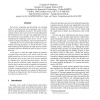Free Online Productivity Tools
i2Speak
i2Symbol
i2OCR
iTex2Img
iWeb2Print
iWeb2Shot
i2Type
iPdf2Split
iPdf2Merge
i2Bopomofo
i2Arabic
i2Style
i2Image
i2PDF
iLatex2Rtf
Sci2ools
CCGRID
2002
IEEE
2002
IEEE
Tracing a Large-Scale Peer to Peer System: An Hour in the Life of Gnutella
Peer-to-peer computing and networking, an emerging model of communication and computation, has recently started to gain significant acceptance. This model not only enables clients to take a more active role in the information dissemination process, but also may significantly increase the performance and reliability of the overall system, by eliminating the traditional notion of the “server” which could be a single point of failure, and a potential bottleneck. Although peer-to-peer systems enjoy significant and continually increasing popularity, we still do not have a clear understanding of the magnitude, the traffic patterns, and the potential performance bottlenecks of the recent peer-to-peer networks. In this paper we study the traffic patterns of Gnutella, a popular large-scale peer-to-peer system, and show that traffic patterns are very bursty even over several time scales. We especially focus on the types of the queries submitted by Gnutella peers, and their associated ...
CCGRID 2002 | Distributed And Parallel Computing | Peer-to-peer | Peer-to-Peer System | Traffic Patterns |
| Added | 14 Jul 2010 |
| Updated | 14 Jul 2010 |
| Type | Conference |
| Year | 2002 |
| Where | CCGRID |
| Authors | Evangelos P. Markatos |
Comments (0)

